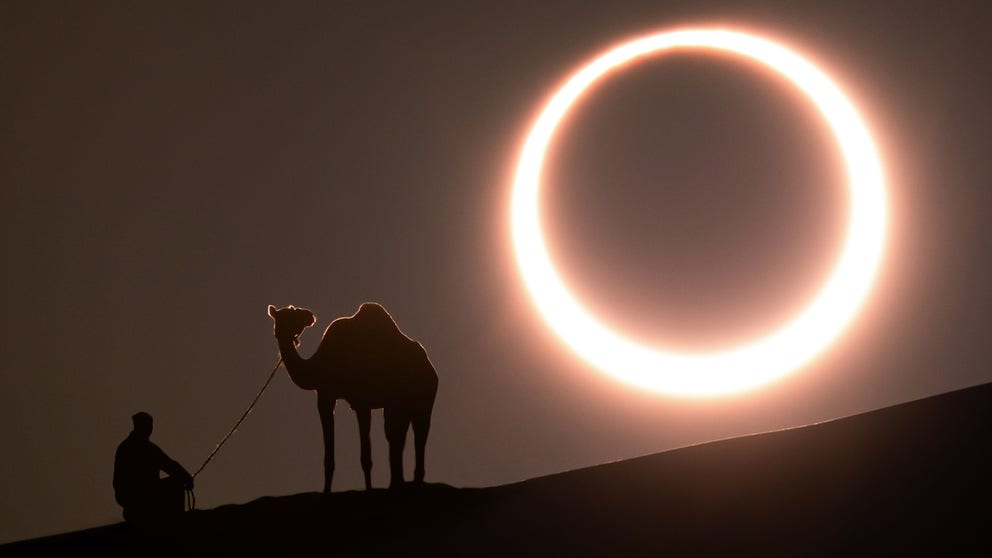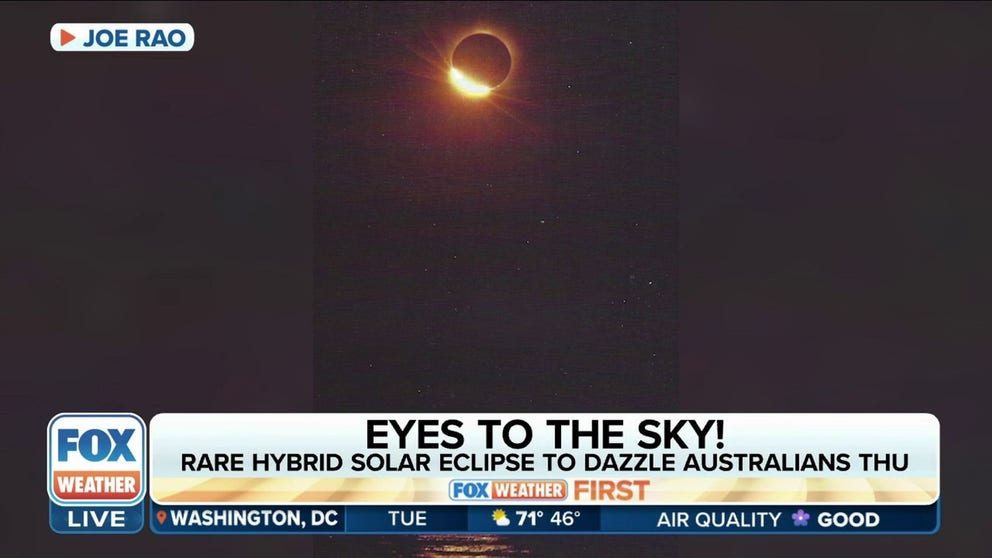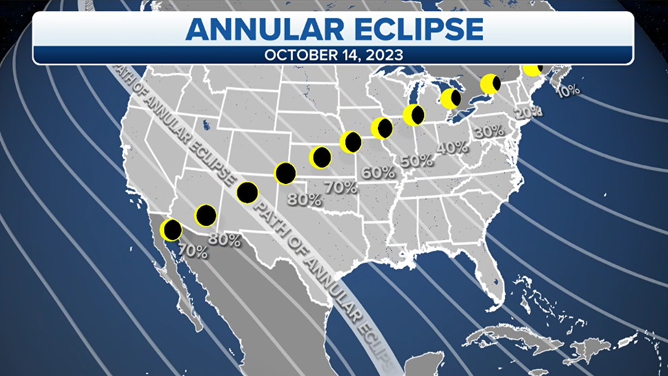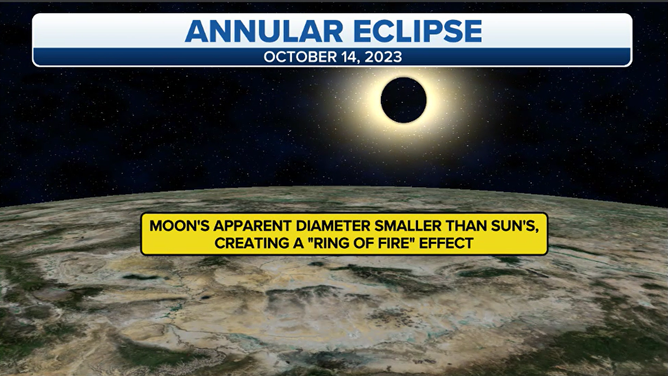What is a solar eclipse?
Solar eclipses happen about every 18 months and only take place during the new moon stage. A total or annular eclipse is a rare event, but a hybrid solar eclipse is considered to be even rarer. The moon’s orbit plays a role in the type of eclipse that is visible.
What is a solar eclipse? The different types and how they happen
During a total or annular solar eclipse, the moon passes in front of the sun and casts its shadow upon the Earth's surface.
Earth’s only natural satellite not only plays a role on the environment, it also occasionally blocks out the sun, causing what is known as an eclipse.
A solar eclipse forms when the moon moves between the sun and the Earth, temporarily blocking light from reaching the globe.
During an eclipse, the moon casts two shadows toward Earth. One of the shadows is called the penumbra, and the more inner one is called the umbra. Light does not reach the umbra, while within the penumbra, or the outer part of the shadow, can see light.
Certain types of eclipses are more common than others, with some occurring a couple of times a year and the rarest happening only once a decade if the celestial bodies align.
There are four main types of solar eclipses: total, partial, hybrid and annular.
It doesn’t matter which solar event is happening; astronomers and health experts alike advise everyone to never directly stare at the sun, even through a camera, telescope, binoculars or any other viewing device. The rays can cause serious eye injuries if the proper eye protection is not worn.
SEE THE OBJECTS HUMANS LEFT BEHIND ON THE MOON
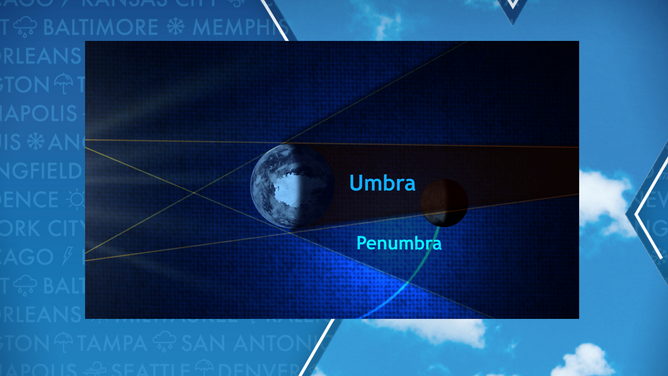
The inner shadow is called an umbra. The outer shadow is called penumbra
(NASA)
Total solar eclipse
Approximately every 18 months, the moon completely covers the sun, leading to a narrow path of totality around Earth, known as a total solar eclipse.
Some version of a solar eclipse happens about twice a year, but finding yourself under the totality of one is rare.
The region of the world that will see the totality will be under the umbra, while those that see some part of the eclipse will be in the moon’s penumbra.
The American Astronomical Society says that any given spot on the planet only sees temporary darkness from the moon’s shadow once every 400 years.
The countdown is already on until the next total solar eclipse that will be visible from parts of North America.
On April 8, 2024, the Great North American Solar Eclipse will cross over Mexico, the United States and Canada. Astronomers say it’ll begin over the Pacific Ocean and be over central Mexico around 2:07 p.m. EDT. After Mexico, the eclipse will pass over Texas, Oklahoma, Arkansas, Missouri, Illinois, Kentucky, Indiana, Ohio, Pennsylvania, New York, Vermont, New Hampshire and Maine.
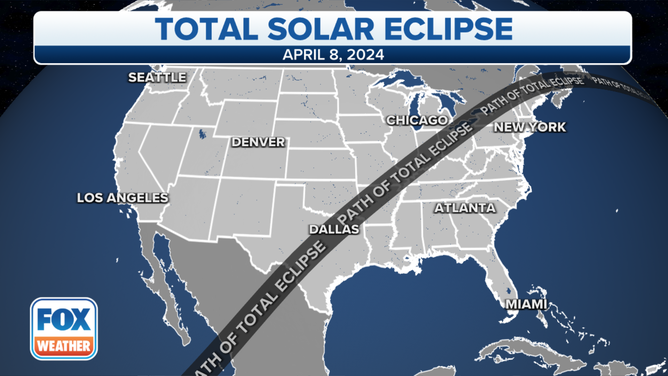
Path of totality during the Great North American Solar Eclipse on April 8, 2024.
(FOX Weather)
The event will be similar in scope to the August 17 eclipse that traveled west to east across the lower 48, with millions that traveled to be under the totality.
Before the event, the eyeglass market was flooded with counterfeit products, and to help consumers before the next big spectacle, the AAS Solar Eclipse Task Force has established a list of companies and manufacturers that meet the ISO 12312-2 international safety requirement: https://eclipse.aas.org/resources/solar-filters.
COUNTDOWN IS ON: 1 YEAR AWAY UNTIL THE GREAT NORTH AMERICAN SOLAR ECLIPSE
Partial solar eclipse
When the sun, moon and Earth are not entirely aligned, but a section of the giant star is not visible, a partial solar eclipse is considered underway.
The portion of the sun covered by the moon can vary from a small sliver to a percentage just short of a total solar eclipse.
According to astronomers, partial eclipses are fairly common and can occur several times a year.
All solar events begin as a partial eclipse, and if the total or annular stage is not reached, the event will remain in the partial category.
TIME ZONE DEBATE HITS THE MOON; WORLD ASKS WHAT TIME IS IT REALLY ON THE LUNAR BODY?
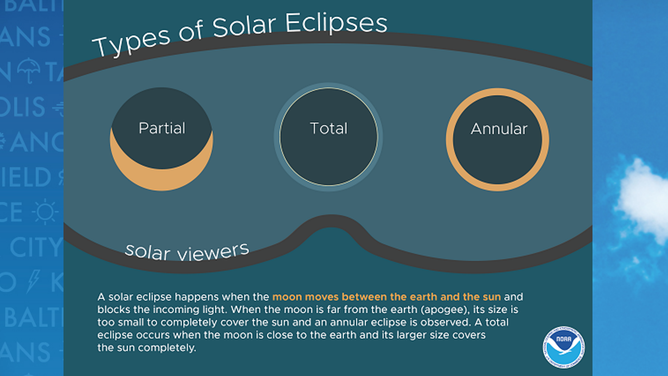
Types of solar eclipses
(NOAA)
Hybrid solar eclipse
A hybrid solar event is the rarest form of an eclipse and only occurs about once every ten years.
Due to Earth’s curvature, a hybrid solar eclipse starts out as a partial and can become either an annular or a total eclipse depending on one’s location.
The moon must be in an orbit that isn’t too far from Earth or else an annular eclipse would not be apparent. A position close to the planet would allow for a total eclipse to be visible. The moon’s temporary position between the two allows for a quick combination of an annular and total event.
According to NASA, the next hybrid eclipse isn't expected to be visible until 2031.
SCIENTISTS DISCOVER STAR DEVOURING PLANET FOR FIRST TIME AND THINK EARTH COULD SUFFER SAME FATE
Rare hybrid solar eclipse to dazzle Australian skywatchers on Thursday
Skywatchers are in for a treat on Thursday as a hybrid solar eclipse will plunge people into darkness on the other side of the world. Joe Rao, Associate Astronomer at Hayden Planetarium, joined FOX Weather to talk about the rarest of all solar eclipses.
Annular solar eclipse
An annular solar eclipse happens when the moon passes between the Earth and the sun while at its furthest point from the globe.
During this episode, the lunar body is more than 250,000 miles from Earth.
Due to its orbit, the moon cannot completely block out the sun, leaving what appears to be a ring around the moon.
Astronomers say an annular solar eclipse is not rare, and at least one occurs every two years.
The last event was on June 10, 2021, and was visible in Canada, Greenland and Russia, with much of the Northern Hemisphere able to see a partial view. The episode was only viewable for a few minutes, as the celestial bodies were constantly in motion.
The U.S. will see its first full annular solar eclipse in over a decade on October 14, 2023.
All of the lower 48 states will see at least a sliver of the sun being obscured, with communities such as Eugene, Oregon; Albuquerque, New Mexico; and San Antonio, Texas, will be treated to the greatest views if skies are clear.
In the path of maximum sun obscuration, 90 percent of the bright start will be covered by the lunar body.
Like the other versions of an eclipse, if you want to look at the moon in front of the sun, specialized eye protection is a must.
